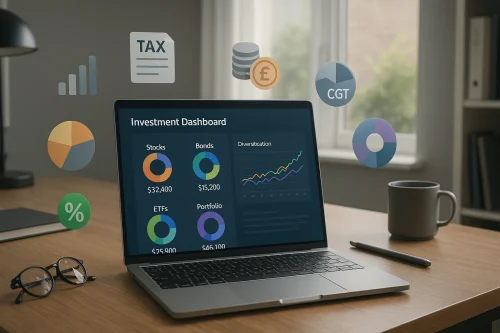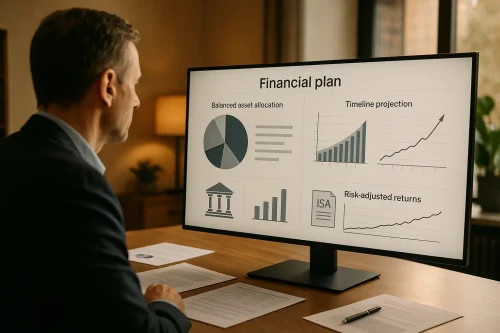Post Contents
Investing £100,000 in 2025 requires a thoughtful approach, especially with shifting interest rates, evolving tax rules, and global market uncertainty.
Martin Lewis, one of the UK’s most trusted financial voices, emphasises balancing risk, protecting capital, and using tax-efficient strategies to maximise long-term growth.
Whether you prefer safe options like bonds and cash savings or want to explore stocks, property, or emerging sectors, understanding how to structure your money is essential. This guide breaks down the smartest ways to invest wisely this year.
What Is the First Question to Ask Before Investing £100K in 2025?

Before placing a single pound into any investment, Martin Lewis stresses the importance of understanding your goals and risk appetite. Many investors rush into high-return opportunities without assessing how soon they may need the money.
A few essential considerations include:
- Do you need access to the full amount within the next 5 years?
- Are you comfortable with potential short-term losses for long-term gains?
- Do you have a solid emergency fund outside of this £100K?
- What tax brackets or thresholds might your investments push you into?
The foundation of any investment decision begins here, as the answers shape how aggressively or conservatively you should allocate funds.
Should You Keep a Portion of Your £100K in Cash Savings?
While cash savings don’t produce the highest returns, Martin Lewis consistently argues that liquidity matters especially during times of economic uncertainty.
For 2025, with unpredictable interest rate movements and inflation cooling but not disappearing, a portion of your total investment should remain easily accessible.
Why Keep Money in Cash?
- It cushions you against financial emergencies.
- It protects you from needing to sell investments at a loss.
- It allows you to take advantage of new opportunities quickly.
- It reduces overall portfolio risk.
Best Cash Savings Options for 2025
| Saving Option | Expected Interest Range | Best For |
| Easy Access Savings | 4.5% – 5.2% | Liquidity and flexibility |
| Fixed-Rate Bonds | 4.8% – 5.5% | Higher predictable returns |
| Cash ISAs | 4.2% – 4.8% | Tax-free interest earnings |
| Premium Bonds | Variable | Low-risk savers who enjoy prize draws |
Martin Lewis also reminds investors to spread savings across banks if they exceed the £85,000 FSCS protection limit, to avoid unnecessary risk.
Is a Stocks and Shares ISA Still a Good Investment for £100K in 2025?
A Stocks and Shares ISA remains one of the most valuable tools for long-term investors, especially when dealing with a substantial amount like £100K.
Martin Lewis frequently highlights the importance of using tax-efficient wrappers, as they allow your money to grow without the drag of dividend tax or capital gains tax.
For readers who want more guidance on structuring a larger lump sum, exploring investing £100k: advice from Martin Lewis offers additional insight into how ISAs fit into a balanced investment plan.
A Stocks and Shares ISA can hold global equity funds, bond funds, REITs, or diversified multi-asset portfolios, giving investors the flexibility to build growth with reduced risk.
It also provides an accessible, tax-free way to invest year after year, making it especially appealing in a period of fluctuating interest rates and market uncertainty. For many savers, it remains a core part of an effective long-term strategy in 2025.
Can You Use General Investment Accounts (GIAs) to Grow Your £100K Further?

Once you max out your ISA allowance (£20,000 per year), the remaining amount of your £100K can go into a GIA. While not tax-free, GIAs offer flexibility and unlimited investment opportunities.
Why GIAs Are Useful for Large Sums?
- No contribution limits
- Access to the same investments as an ISA
- Suitable for long-term investors comfortable with risk
Be mindful of:
- Capital Gains Tax (CGT) limits
- Dividend tax thresholds
- Your personal tax bracket
Proper planning can reduce tax exposure when exiting investments.
Are Government Bonds, Corporate Bonds, or Gilts Smart Choices in 2025?
Bonds offer safer, more stable returns than stocks, making them ideal for investors who want to protect part of their capital. With interest rates expected to fall gradually in 2025, bond values may rise, which presents a good opportunity for fixed-income investors.
Bond Comparison Table
| Bond Type | Risk Level | Expected Return | Best For |
| UK Gilts | Low | 3% – 4% | Low-risk investors |
| Corporate Bonds | Medium | 4% – 6% | Those seeking stability + returns |
| Bond Funds | Medium | Variable | Mixed-income diversification |
| Inflation-Linked Bonds | Low-Medium | Inflation-adjusted | Protecting purchasing power |
Martin Lewis typically highlights gilts and corporate bonds as reliable anchors for diversified portfolios.
Should You Consider Investing in Property With £100K in 2025?
Property continues to be a popular investment option in the UK, but the landscape has changed significantly due to tax reforms, mortgage rules, and landlord regulations.
When Property Investment Makes Sense?
- You aim for long-term capital growth
- You can handle maintenance, insurance, and taxes
- You’re prepared for tenant management
- You have additional cash for unexpected costs
Property returns can outperform markets during regional growth cycles, but being a landlord requires commitment.
Here are the main options for using part of your £100K:
- Buy-to-let residential property
- Commercial property
- REITs (Real Estate Investment Trusts)
- Crowdfunded property platforms
In 2025, REITs offer a lower-effort alternative with consistent dividends and reduced hassle.
Are Pension Contributions a Smart Way to Invest Part of Your £100K?
Martin Lewis frequently emphasises that pensions offer unmatched tax benefits. For higher-rate or additional-rate taxpayers, contributing to a pension can be one of the most efficient ways to grow wealth.
Why You Should Consider Pension Contributions
- Receive 20–45% tax relief depending on your income
- Employer contributions multiply your savings
- Investments grow tax-free inside the pension
- Long-term, inflation-beating potential
A significant portion of your £100K could be directed into:
- A workplace pension
- A private SIPP
- A Lifetime ISA (if under 40)
Increasing pension contributions can also reduce your taxable income.
Is Diversification Essential for Investing £100K Safely?

Martin Lewis always highlights the golden rule of investing: never put all your eggs in one basket. Diversification spreads risk across markets, asset classes, and regions.
A balanced £100K portfolio might include a mixture of:
- Cash savings
- Global equity funds
- Government or corporate bonds
- Property-related investments
- Pension contributions
- Ethical or ESG funds
This structure protects you against market shocks while capturing steady long-term growth.
How Can You Spread Your £100K Based on Risk Level?
Your risk tolerance determines how much of your £100K should be placed in safer assets versus growth-focused investments. Martin Lewis often highlights that spreading your money across different types of investments can reduce risk while improving long-term returns.
To help you visualise how different strategies look in practice, here is a simple comparison of portfolio types:
Portfolio Breakdown by Risk Level
| Risk Level | Cash | Equities | Bonds | Property | Alternatives |
| Low Risk | 40% | 20% | 40% | – | – |
| Medium Risk | 25% | 35% | 25% | 15% | – |
| High Risk | 10% | 70% | – | – | 20% |
A low-risk investor focuses heavily on cash and bonds to protect capital. A medium-risk investor balances steady growth with stability, while a high-risk investor leans into equities and alternative markets for potentially larger gains.
Martin Lewis generally recommends a medium-risk approach for most people, as it offers growth without exposing your full capital to volatility. Small adjustments can be made depending on age, income, and how soon you plan to use the money.
Are Emerging Opportunities Like Green Energy, AI, and ETFs Worth Considering in 2025?
The investment world continues to evolve, and 2025 brings a new wave of high-potential sectors. While these sectors can offer strong long-term returns, they also involve greater unpredictability.
Martin Lewis encourages exploring these areas only as part of a balanced portfolio, rather than committing a large portion of your savings to a single theme.
Key opportunities drawing investor attention include green energy, artificial intelligence, healthcare advancement, and automation technologies. Global emerging markets also remain appealing due to rapid economic expansion.
To simplify things, here’s a table showing how these sectors typically fit into a modern investment strategy:
High-Growth Sector Snapshot
| Sector | Why Investors Consider It | Typical Use in a Portfolio |
| Green Energy | Growing demand for sustainable solutions | Long-term thematic growth |
| Artificial Intelligence | Rapid adoption across industries | Tech-focused diversification |
| Healthcare Innovation | Stable demand + new breakthroughs | Defensive + growth exposure |
| Robotics & Automation | Workforce changes and efficiency | Mid-long term growth theme |
| Emerging Markets | Fast-growing economies | Geographical diversification |
Low-cost ETFs make it easier to enter these markets without choosing individual stocks, helping investors gain broad exposure while keeping risk manageable.
What Are the Biggest Mistakes to Avoid When Investing £100K?
Even seasoned investors can make costly errors when managing a six-figure sum. Martin Lewis regularly emphasises the importance of avoiding emotional or rushed decisions, especially during unstable economic periods.
Common mistakes include chasing high returns without understanding the underlying risks, entering a market at the wrong time, or ignoring tax-efficient options such as ISAs and pensions. Another frequent issue is putting too much money into one asset class, which can lead to significant losses if that sector declines.
It is also crucial to avoid unregulated schemes, aggressive sales tactics, and overly complex products that promise guaranteed high returns. These often come with high risks and little consumer protection. A structured, calm plan with a focus on long-term goals remains the best safeguard.
What Should Your Final Investment Strategy Look Like in 2025?

A smart, balanced strategy rooted in Martin Lewis’s principles combines safety, growth, and tax efficiency. While the exact percentages depend on your age, financial goals, and risk tolerance, the overall structure should remain stable.
A well-rounded plan typically includes a cash buffer to manage unexpected costs, the full use of a Stocks and Shares ISA for tax-free growth, and a diversified global equity fund to spread risk across markets. Bonds can bring stability, while property or REITs offer inflation-linked income potential.
Pension contributions also play a major role because the tax relief significantly boosts long-term returns. Finally, planning around tax thresholds helps ensure you keep more of what your investments earn.
Putting these elements together gives you a strategy that protects your capital, grows your wealth steadily, and remains flexible enough to adapt as financial conditions change.
Conclusion
Choosing how to invest £100,000 in 2025 becomes far easier when you follow clear, practical guidance rooted in Martin Lewis’s core principles: diversify, protect your cash flow, minimise tax, and stay focused on long-term stability.
A balanced strategy combining savings, equities, bonds, pensions, and selective high-growth opportunities can help you grow your money steadily while reducing unnecessary risks.
As financial markets continue to shift, reviewing your plan regularly ensures your investments stay resilient, efficient, and aligned with your future goals.
FAQs
What’s the safest way to invest £100K in 2025?
Keeping part of the money in cash, bonds, and diversified low-risk funds offers stability with minimal volatility.
Is now a good time to invest in the stock market?
Yes, but only with a long-term outlook. Markets may fluctuate, but diversified global funds help reduce risk.
Should I put all £100K into one investment?
No. Martin Lewis strongly recommends diversification to protect your money from market downturns.
Can I invest £100K tax-efficiently?
Yes using ISAs, pensions, and careful tax planning helps reduce capital gains and dividend taxes.
Is property still a smart investment in 2025?
It can be, especially through REITs or rental properties, but investors should consider higher costs and regulations.
How much of £100K should stay in cash?
Most experts suggest keeping 10–25% easily accessible as an emergency buffer.
Are high-growth sectors like AI and green energy worth exploring?
Yes, in moderation. These sectors offer strong potential but carry higher risk, best used as part of a balanced portfolio.


